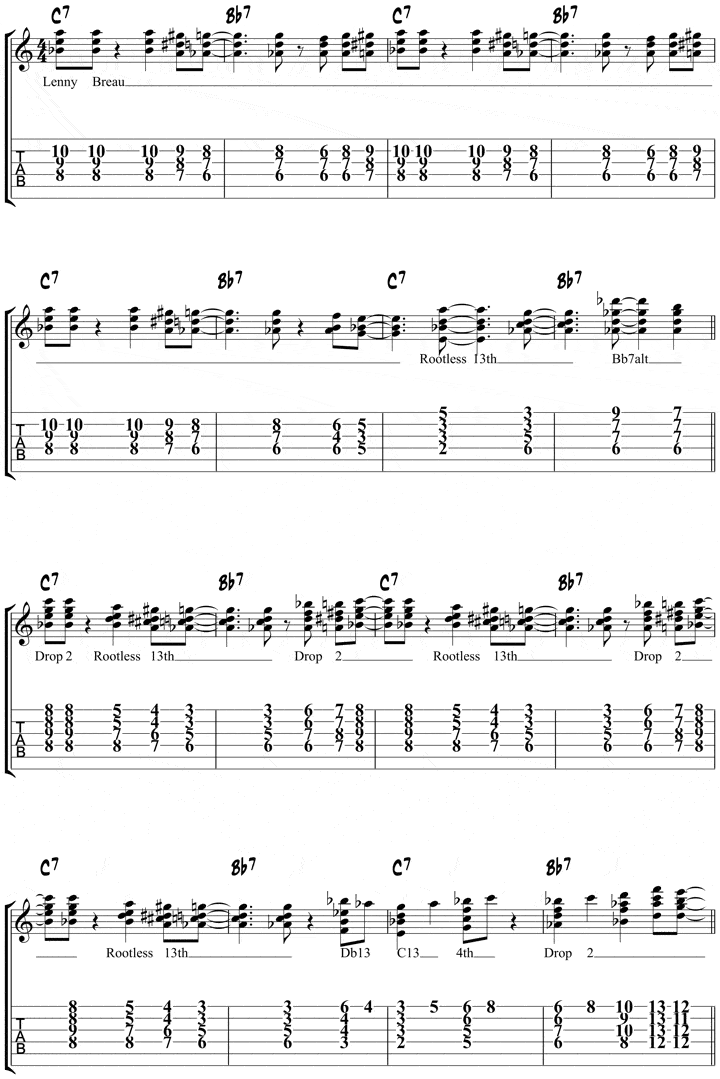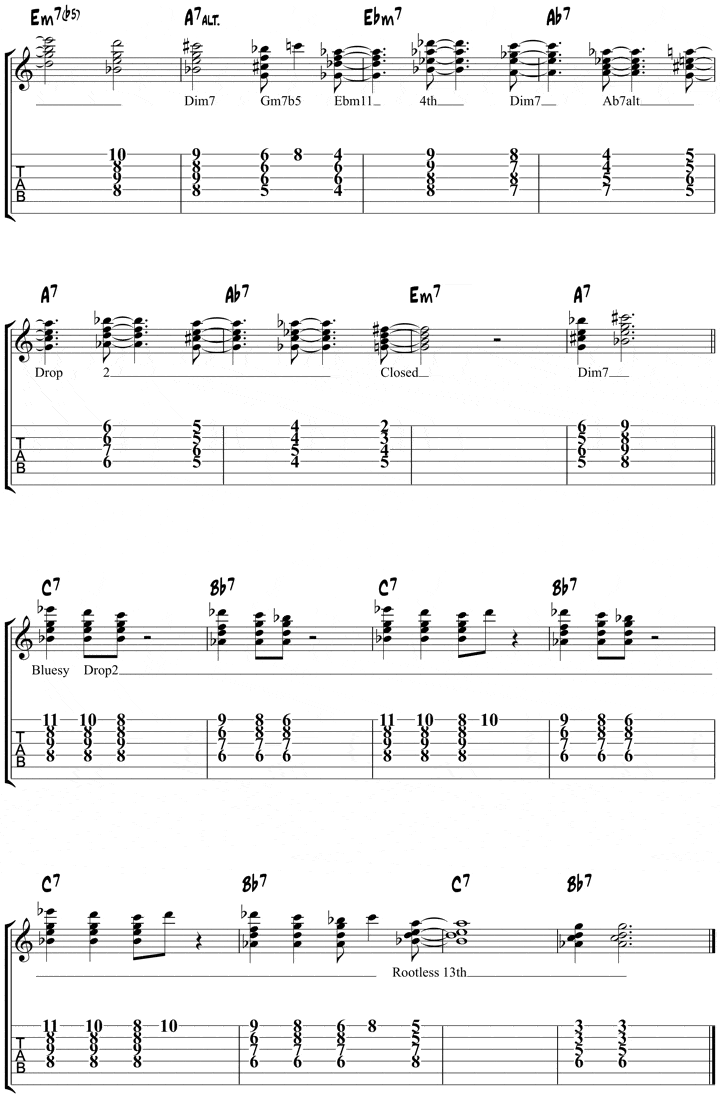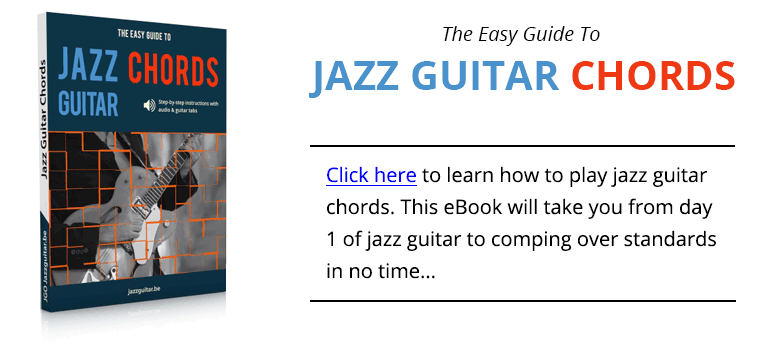A fun and interesting chord progression, the tune Killer Joe is a commonly called jazz standard on jam sessions and gigs. While the tune looks easy from an initial look at the chords, especially the A sections which are only two chords, it can be tricky to keep things from becoming monotonous when playing over these changes.
Below you will find a chord study written out over the changes to Killer Joe that uses melodic comping phrases to outline the changes. This keeps things interesting and prevents the tune from becoming predictable.
What’s In this Killer Joe Chord Study
There is text written under many of the chords in the tune. This text is to indicate the chords used in that part of the chord study.
Here is a bit of background on each of these chord concepts that you can use to understand the underlying theoretical building blocks of the chord study. From there, you can use these concepts to build chord studies over this tune and other tunes.
Lenny Breau Chords – These chords are inspired by the playing of the late, great Lenny Breau. They use the 3rd and 7th as the lowest two notes, or 7th and 3rd, with one color note placed on top of those notes to form the whole chord shape.
Rootless 13th Chords – Built by taking the root out of the 7th chord, and adding the 13th and most of the time the 9th, these shapes were a favorite of Joe Pass and are a great way to spice up your comping ideas.
7alt Chords – When playing over dominant 7th chords, and you want to add a level of tension to your playing, you can add in the altered notes to your chords (b9-#9-b5-#5). This will create a sense of tension that you can then resolve to the next chord in the tune.
Drop 2 Chords – Built with the interval structure R-5-7-3, with inversions created from that root-position shape, drop 2 chords are some of the most commonly used shapes in jazz guitar.
4th Chords – Quartal chords are built by stacking 4th intervals, rather than the traditional 3rd intervals, to create three and sometimes four-note shapes on the guitar.
Closed Chords – Closed shapes are built by placing all of the chords in the order that they appear, such as 1-3-5-7, and are sometimes inverted from that beginning position.
Dim7 Chords – When outlining 7b9 shapes, you can play dim7 chords from the b9, 3, 5 and b7 of the dominant 7th chord in order to build a rootless 7b9 sound in your playing.
Bluesy Drop 2 Chords – These shapes are built by adding blues and other diatonic notes on top of drop 2 chords in order to create a bluesy sound in your comping ideas.
Killer Joe Chord Study
Here is the full chord study for you to practice.
Each 8-bar phrase has been written to be a unique part of the tune as a whole, which means that you will be able to isolate each 8-bar phrase, learn it on its own, and then combine them all to form the tune as a whole.
You can use your fingers to play these chords, or a pick, or hybrid pick-fingerpicking when learning this chord study.
Whatever works for you and is the most comfortable will work as long as it allows you to play the chords smoothly and accurately.
Killer Joe Backing Track
To help you learn this Killer Joe Jazz Guitar Chord Study in the woodshed, here is a short backing track that you can use to play along with in the practice room.
Note that the track is at a performance tempo, a bit quick when first learning the study, so work these chords with a metronome first and then move on to this track when you have the study memorized at a good tempo.
Further Reading
Summertime Jazz Guitar Chord Study
Blue Bossa Jazz Guitar Chord Study
Do you have any questions about this Killer Joe Jazz Guitar Chord Study? Share your thoughts in the comments section below.





Hi you sure made a great job here. I quite agree Killer Joe is a falsely simple tune.
I would like to share with you a discovery I made when transcribing the theme.
Actually I found out quickly the two chord-balance on A, but struggled more on the bridge. At the end I tried an original and simple progression : parallel dominant chords, simply following the melody !!
So : G7 % lIA7 Bb7 llC7 C#7 llD#7 E7
It seems to work, although totally different from the « certified » progression … I really don’t know why !
Your opinion please ?
Christophe
Great stuff !
Another cool jazz guitar chord comping etude.Thanks Matt,I can’t thank you enough for these great lessons that are bringing back the fun and very much worth working on.
Hey Matt, I had a question about the second rootless 13th chord played in the 7th bar.
It’s spelled out G#, C, D, G. If applicable to an E chord it would the 3rd, minor 6th, dom 7th, and then a minor 3rd (is that correct? not my question) I was wondering why the minor 3rd in place of a 9th other than having an interesting tonal property. Or are you basing rootless 13th off of another chord? Thank you
Ivan
Hey Ivan. That chord is actually spelled with an Ab not G#, that’s probably what’s causing the confusion. If you look at it with an Ab it becomes a Bb13 rootless chord, which fits the Bb7 chord that’s in the progression at that point. Hope that helps!
Sometimes it takes that outside eye to help! Thank you very much, Matt. I had one more question for you about the 18th bar of this piece. I can’t hear the Ebm11 chord played in the recording at all. Can you shed any light on this? Thanks again and as always great work!
My mistake, Matt I heard a the chord (In a different register maybe? seemed rather high pitched than it would normal at that register of the neck.) Sorry about that.
I love all the lessons.
I am an amateur musician and I have no words to classify your work.
Thank you very much.
honestly i did nt understand d lesson how i wish u can put me through tnx
Thanks so much . Fun tune to play .
thank you !! I appreciate all your lessons.
Tyvm. Great lesson. Its hard to remember all the positions but ill try my best.
Thanks, I had fun playing this.
What helps me to memorize the different functions of the 4th chords? How many functions does it have ?
What a really good lesson thanks so much for all your input and help with this wonderful Genre,
Please keep up the good work.
Cheers.
First of all, thank you so much for all you give and give. I am a paying customer, having bought the ‘3 special’ a while back: Premium Guitar Gazette, and 2 eBooks. I do have a negative comment. I would rather have a classic Killer Joe to learn. Your version here may be technically correct, but my ear says it goes all over the place and just when I think it is going to resolve, it doesn’t. I felt the same way about A Train and a little that way about Blue Bossa. How Insensitive, on the other hand, was right on at least 90%. Just to check where I’m coming from, I went to YouTube to find a classic version and got stoked with Rich Severson’s version. In fact, I paid $5 for the lesson download. Thanks!
Thanks very much for a great routine . Love it.
A novice jazz guitar player but this sort of stuff is so helpful and inspiring. Can’t say thanks enough.
Thanks Dirk, gorgeous chord voicings!
Thanks again Dirk.
What a great tutorial! I just love the comments where the lyrics are normally displayed. I loved this site before I started recieving the ‘new chord study’ emails. Now its the first site I check out each morning. Its being recommended to all my guitar buddies.
Thanks
Thanks Dirk & Matt
you seem to have an inexhaustible supply of good material
i dub you the dynamic duo.
Sweet lesson! Great for moving around on the neck. I’ll be looking at this again tomorrow!
Superb! Thanks.
Hi, it would be very nice if there was a printable format available for the great lessons. Then I could practice from the sheet music without the computer and go back to the computer for backing tracks and audio.
Hey, keep your eyes out later this spring/early summer as we’ll have printable versions of 20 of these chord studies available in an off-line form.
Just back from the back roads of Fla.where i tried to to rig up an alligator and panther to get signal.No deal so i get back and get connected and here is THE TEAM (thanks Matt for helping me realize i have a team!)giving up some more elegance class with attitude and intellect.Thanks great lesson.E
So elegant.. thank you 🙂
Hey Dirk, the Sound Cloud does not work .. where is the player?
Is there any method(s) you’ve followed to get a hang of this stuff? There are sort of garden-variety jazz chords, so to speak, but how to actually get this level of comping? Not even to mention chord melody … ?
Jamming with musicians, or recordings, is a great way to take these from the page to sounding musical.
You want a method,simply copy all of Matt’s comping arrangements,come up with a few variations as I have, and your on the right road,Thanks Matt for all of your comping studies,I am really learning a lot!!!
Sorry – MATT! Credit to where it’s due. Sorry about that. Really great work!
No problem, definitely a team effort! 🙂
it’s very good please put diagram
thank’s
Brilliant Dirk! Thanks yet again!!